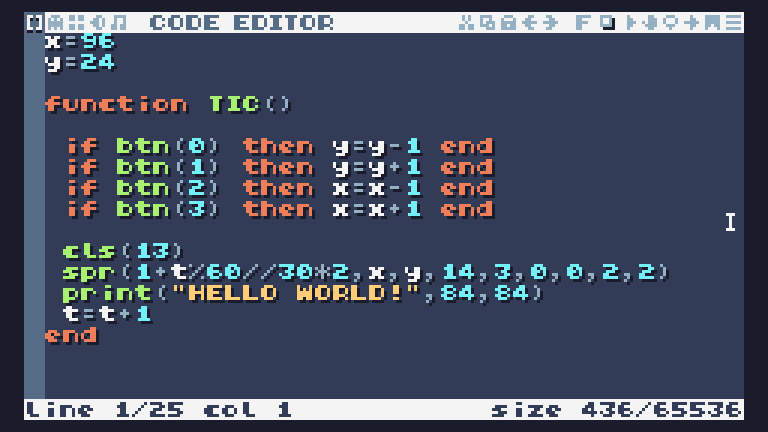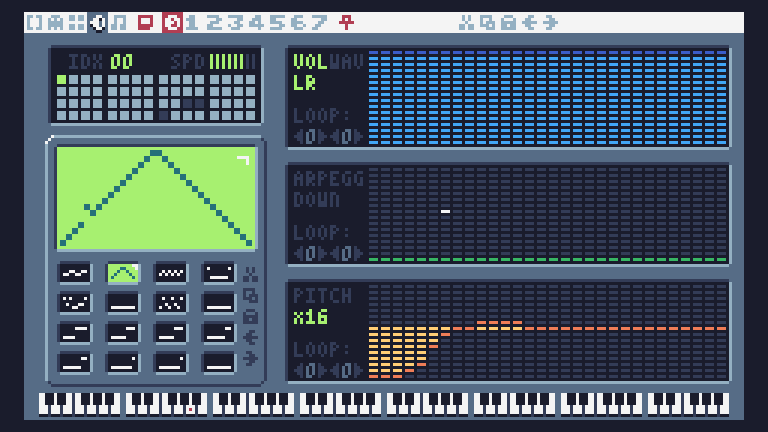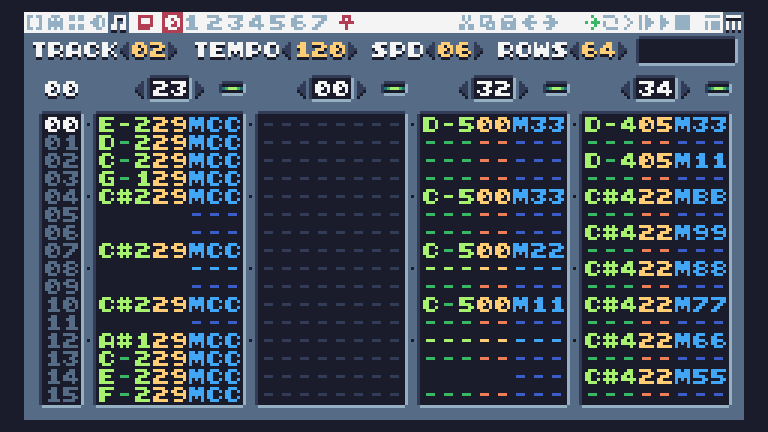Achieve gamedev nirvana with TIC-80
What is TIC-80?
- TIC-80 is a free and open source fantasy computer
- Similar to Pico-8, the most well-known fantasy console
- More versatile, though. No shade
- Great for making, playing and sharing tiny games
- Built-in tools for development: code, sprites, maps, sound editors and the command line
- Artificial limitations: low resolution, color palette, chiptune channels, game size…
- The game is stored as a
.ticcartridge file- It can be uploaded to the TIC-80 website
- (…but you can also export executables!)
What can you make with TIC-80?
- Bare bones
- 2D dungeon crawler
- Supernova
- 3D racer
- Fallspire
- Demoscene demo
- EMUUROM
- A full-fledged Steam release?!?
Basic navigation
- TIC-80 boots into the command line
- This is used for debugging and moving in the filesystem
- You can move between the editor view and the command line by pressing ESC
- You can move between different editors with the F keys
- More hotkeys here
Editors
Code editor (F1)

- 64KB of code
Sprite editor (F2)
![]()
- 512 8x8 sprites divided into foreground and background
- Changeable 16-color palette
Map editor (F3)

- A single-layer map of 240x136 8x8 tiles
Sfx editor (F4)

- 16 sound waveforms you can draw yourself
- 64 instruments
Music editor (F5)
- 8 tracks consisting of 60 patterns
Piano roll view:

Tracker view:

Display coordinates

What about the nirvana part though
- Only one window: no distractions!
- No compile time: Test your creations INSTANTLY.
- No bullshit: If you want to paint a pixel red in
(x=30, y=15), you can. - Low resolution & ready-to-use 16 color palette:
- Some decisions are already premade for you, by the engine.
- Just make your game.
- Limited yet expressive set of tools
- Limitations breed creativity, after all!
Hello world game
- Use the
new luacommand to create a new default cartridge programmed in Lua - Use the command
runor press CTRL+R to run the game. - ESC pauses the game.
- Let’s now remove the default code and try to recreate the important parts.
- HOX: In version 1.0, you have to turn on Dev Mode to make transition between the game and the editors faster
menu> Options > Dev Mode: ON
- The most important function we need is TIC, the main loop which runs in 60 fps.
- Inside it, you put everything that you want to update & draw on screen
- So let’s put a print call inside it to draw text on screen
- We can also use the spr function to draw a sprite
- Then, we can make the sprite move by getting input: btn
- Now we notice that the screen doesn’t get cleared automatically. Let’s call cls
- …and we’re done!
Lua in a nutshell
- Lua is the default programming language of TIC-80.
- Some others are supported as well
- Learn Lua in 15 minutes
- Lua is a Python-like dynamic language where indents don’t matter.
-
if huge then return true end -
for i=1,10 do trace(i) end -
function increment(a) return a+1 end
-
- By default, every variable has a “falsy”
nilvalue - Variables are
globalby default (use thelocalkeyword!) - Tables are everything and can have everything
- You can have numbered and named keys in the same table
tbl = {"hello", "world", name = "sillyTable",} for index, value in pairs(tbl) do trace(value) end
- You can have numbered and named keys in the same table
- Gotchas
- Table indexing starts from one:
tbl[1] -
if a ~= 3 then trace("a is not 3") end +=does not exist
- Table indexing starts from one:
Important API functions
Basics
- TIC
- Callback function for the main loop. Called once per frame, 60 times per second
- System
Drawing
- cls: Clear screen
- print: Print text
- spr: Draw sprite
- pix: Draw a pixel
- line: Draw a line
- map: Draw tilemap
- circ & circb: Circle & Circle border
- tri, ttri & trib: Triangle, Textured triangle & Triangle border
- rect & rectb: Rectangle & Rectangle border
Input
- Controller & keyboard (by default, ABXY buttons are mapped to ZXAS keys)
- key & keyp: Get input from keyboard “
GetKey” & “GetKeyDown” - mouse: Mouse input
Sound
Memory
- mget & mset: Get & set tile in tile map
- fget & fset: Get & set sprite flag
- pmem: Get or set value in persistent memory (load & save!)
- peek](https://github.com/nesbox/TIC-80/wiki/peek) & [poke: manipulate internal RAM & VRAM
Tricks
- BDR
- Callback function for drawing or manipulating stuff between every “scanline”, plus border
- Called 143 times per frame
- Manipulating the color palette
- More graphics with less colors: bits per pixel
Console
- Console: Available commands
new,load,save: manage cartridgesrun: run loaded gameresume: when running a game, you can go to console with ESC and resume playfolder: open the working directory in the host OShelp: Show available commands, or explanation for API functions & specific commandsexport: Export game or assets (very versatile)export winexport music id==1: Export song 1- etc…
Examples
Boilerplate code
- Button indices (so no need to remember numbers with btn)
UP=0 DOWN=1 LEFT=2 RIGHT=3 A=4 --z B=5 --x X=6 --a Y=7 --s
- Math shorthands & helper functions
pi=math.pi max=math.max min=math.min sin=math.sin cos=math.cos exp=math.exp abs=math.abs sqrt=math.sqrt rnd=math.random floor=math.floor ceil=math.ceil angle=function(x,y)return math.atan2(y,x)end function sign(n) return n>0 and 1 or n<0 and -1 or 0 end function clamp(n,lo,hi) return min(max(n,lo),hi) end function lerp(a,b,t) return (1-t)*a+t*b end--t=0..1 function dist(a,b) return sqrt(a^2+b^2) end function round(num, decplaces) local mult = 10^(decplaces or 0) return math.floor(num * mult + 0.5) / mult end function AABB(e,v) return v~=e and e.x+e.w>v.x and e.x<v.x+v.w and e.y+e.h>v.y and e.y<v.y+v.h end
- Table shorthands & helper functions
str=string.format del=table.remove to=table.insert sort=table.sort function rm(tbl,E) for i,v in ipairs(tbl)do if v==E then del(tbl,i)return end end end function has(tbl,val)--if tbl has val, returns key for k,v in pairs(tbl)do if v==val then return k end end return false end function any(tbl,cond)for i,v in pairs(tbl)do if cond(v,i)then return true end end return false end function one(tbl,cond)local n=0;for i,v in pairs(tbl)do if cond(v,i)then n=n+1 end end return n==1 end function all(tbl,cond)for i,v in pairs(tbl)do if not cond(v,i)then return false end end return true end function find(tbl,cond)for i,v in pairs(tbl)do if cond(v,i)then return v end end end function filter(tbl,cond) local filtered={} for i,v in pairs(tbl)do if cond(v,i)then to(filtered,v)end end return filtered end function ripairs(t)--reverse ipairs. https://gist.github.com/balaam/3122129 return function(t,i) i=i-1 if i~=0 then return i,t[i] end end, t,#t+1 end
Simple structure example
ents = {}
table.insert(ents, {
spr=1,x=0,y=0,
upd=function(E)
E.x=btn(2) and E.x-1 or btn(3) and E.x+1 or E.x
E.y=btn(0) and E.y-1 or btn(1) and E.y+1 or E.y
drw=function(E)
spr(E.spr,E.x,E.y)
end
})
function TIC()
for i,E in ipairs(ents)do
E:upd()
end
for i,E in ipairs(ents)do
E:drw()
end
end
Simple tile collision
function tile(x,y)
x,y=(x)//8,(y)//8 --floor division
local id=mget(x,y)--get tile id in given coordinates
return {x=x*8,y=y*8,id=id}
end
function collision(ent) --A very simple tilemap collision detection.
--if tile has flag 1, it's regarded as a collision (set in sprite editor)
local tils
ent.x=ent.x+ent.dx --x direction collision.
if ent.dx<0 then --going left
tils = {tile(ent.x,ent.y),tile(ent.x,ent.y+7)}
for i,til in ipairs(tils) do
if fget(til.id,1) then ent.x = til.x+8 end
end
else --going right or staying in place
tils = {tile(ent.x+8,ent.y),tile(ent.x+8,ent.y+7)}
for i,til in ipairs(tils) do
if fget(til.id,1) then ent.x = til.x-8 end
end
end
ent.y=ent.y+ent.dy --y direction collision.
if ent.dy<0 then --going up
tils = {tile(ent.x,ent.y),tile(ent.x+7,ent.y)}
for i,til in ipairs(tils) do
if fget(til.id,1) then ent.y = til.y+8 end
end
else --going down or staying in place
tils = {tile(ent.x,ent.y+8),tile(ent.x+7,ent.y+8)}
for i,til in ipairs(tils) do
if fget(til.id,1) then ent.y = til.y-8 end
end
end
end
More nirvana
- Small API
- We basically went through 80% of it already
- Takes very little time to learn EVERYTHING about the engine!
- No game-breaking engine updates
- Before 1.0, updates have brought some changes
- Changes can still happen, but it’s fast to migrate your project to the newest version
- Open-source: You can make your own forks of the engine and suggest changes, bugfixes, new features….
- Ever growing friendly community (Discord & Telegram)
Pro mode
- There’s also a paid ($10) PRO version of TIC-80
- 8 times the size with memory banks
- You can swap between e.g., different sprite banks in runtime
- (only one swap per frame per bank!)
- 8 times 64KB for code, no banks
- You can swap between e.g., different sprite banks in runtime
- You can save cartridges as text (
.lua, etc) so you can edit code in external editors- Also, because your whole game is stored as a text file, you can easily extend TIC-80 functionality with Python scripts and the like
- Bonus: You can export games to executables that don’t contain the TIC-80 editors
- Bonus 2: Separate your game into multiple files with
require("file.lua")!
Where to learn
- Learn Lua in 15 minutes
- The TIC-80 wiki
helpcommand- Write e.g.,
help printto know how theprintfunction is used
- Write e.g.,
- tic80.com: Tool cartridges
In a nutshell
- All tools in one window: Fast prototyping!
- Create retro-ish games with direct memory access
- …but with the convenience of dynamic programming languages
- (bonus: get cool retro glitches!)
- Wishlist EMUUROM